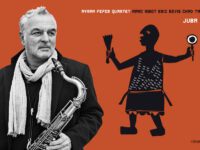by Pico
If I were to tell you that I’m going to discuss the sax playing skills of a certain Dutch lady, you might think I’m talking about Candy Dulfer. Not hardly. Tineke Postma (pronounced TEE-na-ka POST-ma), from Heerenveen, The Netherlands, is an alto and soprano saxophonist who has a much deeper commitment to the straight jazz, and while going that route might not gain her the commercial success Ms. Dulfer has enjoyed, Postma is attracting evermore acclaim and a following, picking up awards at European jazz festivals and touring in more than 20 countries. During 2009 Postma toured leading a quartet that boasted a killer American rhythm section of Terri Lynne Carrington on drums, Scott Colley on bass and Gerri Allen on piano. But before hitting the road, the foursome hit the studio and laid down the tracks that make up The Traveller, Postma’s newest release as of January 12.
At 31 years old and with this being her fourth record, you can really feel Postma come into her own. All but one of the nine tracks came from her own pen, but aren’t predictable and each possess their own unique character. The commonality of them all is that Postma manages to find a way to utilize the vast talent at her disposal without shutting out listeners who want soul soothing jazz. The decision to stick with a stable set of musicians who bought wholeheartedly into her vision also contributed to the album’s unity.
There are a lot of standout tracks on The Traveller. “Song For F”, for one, has a lot of good things going for it. Starting with a mellifluous a spiritual melody, Postma plays a soulful soprano, that’s overdubbed for part of her solo by her alto. But Allen steals the spotlight with a superb piano solo, and all throughout she shows why she’s been a top jazz pianist for the last quarter century, comping, soloing and effortlessly straddling the line in-between all throughout this album.
Allen even uses a Fender Rhodes for the blues based “The Eye Of The Mind,” to great effect, in a way that’s very reminiscent of Chick Corea. “Crazy Stuff” was inspired by Ornette Coleman but Colley reveals a melody that’s more traditionally rooted. However, Allen demonstrates the beauty of a “less is more” approach, and Carrington tosses in a thoughtful drum solo short on clichés. “Adagio 13 – Heitor Villa Lobos” is Postma’s own creative adaptation of the Brazilian composer’s piece conceived for a string quartet. Postma does a commendable job teasing out bright strands of harmonic colors from a classical composition. “Cabbonal” is Postma’s tribute to Cannonball Adderley, but Colley’s and Carrington’s shifting rhythms often takes the songs to places further out than where Cannonball often tread. “Motivation” runs on 7/4 time and Allen again shows great agility meeting the demands of both melody and rhythm with equal attention.
“YWC” ends the set strong; Colley and Carrington form this seductive groove and Allen and Postma play a knarly unison line over it. The chorus shifts into a more lyrical mood, and the improvisation portion consists of Postma and Allen trading bars in a prescient conversation.
The Traveller is just further proof of my contention that women jazz artists are increasing moving from behind the microphone and into the band, successfully taking up prominent positions as instrumentalists, soloists and composers. The future of jazz belongs to the likes of Tineke Postma.
- Tomeka Reid Quartet – ‘3+3’ (2024) - April 30, 2024
- Claudio Scolari Project – ‘Opera 8’ (2024) - April 25, 2024
- Nick Millevoi – ‘Moon Pulses’ (2024) - April 23, 2024



